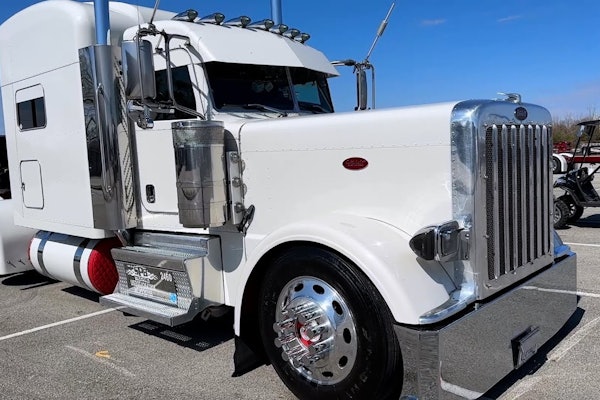Since the Sept. 11 terrorist attacks, owner-operators and carriers have been bracing for insurance rate hikes that many expect to be worse than those of the past few years. Many owner-operators have been insulated from the double-digit percentage increases in insurance costs that fleets have faced, but that appears to be changing. Peter Pomerenke, an agent with Truck Insurance Mart, says he sees rates rising from as little as 10 percent for the lowest risk operators to 30 percent for more marginal ones.
“We saw prices start to go up about the first of 2001,” he says. “So we can’t blame all of this on Sept. 11. We’ve gone from 100-plus insurance providers writing truck policies a few years ago to about 30 or so now.”
But insurance companies and the reinsurance companies that cover their risks, which often share more than 50 percent of the liability on a truck policy, are struggling to pay an estimated $40 billion in Sept. 11-related claims. Many will pass those costs, as well as the cost of higher risks associated with future terrorism, to customers.
Greg Feary of Scopelitis, Garvin, Light and Hanson, an Indianapolis law firm that specializes in transportation insurance law, says insurers are probably going to raise rates for most fleets 30 percent to 35 percent in January and a similar amount in July. That’s when most reinsurers renew their annual contracts with insurance providers.

“If you have a sweetheart deal, your changes are going to look dramatic,” Feary says. Those already paying high premiums may not see such a dramatic increase.
Trucking companies may have a hard time passing on increased insurance costs. “Shippers don’t want to pay the extra costs,” says Norris Beren, a risk management consultant and retired insurance broker. “Shipper margins are so thin. Somewhere along the way someone will have to bite the bullet.”
Beren thinks owner-operators will be among those hit, though they won’t see the big increases fleets face because the cost of insuring equipment isn’t going up. “Most owner-operators only have to insure their trucks,” he says. Leased owner-operators don’t have to worry about liability or cargo insurance, where premiums are expected to spike, though independents do.
Liability and cargo insurance will be more costly for independents, and leased drivers may have to pay higher deductibles.
“We haven’t seen any rate increases yet,” says Brenda Guffey, property and casualty insurance manager for the Owner-Operator Independent Drivers Association. “Our rates were pretty stable before Sept. 11, and our reinsurer believes it may stay the same.”
Even so, Guffey says, more carriers are sharing their insurance burden by requiring leased owner-operators to pick up all or some of the deductible after a preventable accident. If carriers in the coming months choose higher deductibles to avoid higher premiums, they will have greater pressure to make owner-operators absorb a bigger share of deductibles.
Guffey says many leased owner-operators, who are generally only responsible for physical damage and bobtail insurance, are unaware that fleets may hold them accountable for a deductible.
“One owner-operator who hauls heavy machinery called me about his lease,” Guffey says. “Two weeks after a load, his carrier took a $7,000 hit when the machinery was unwrapped at the receiver and was found damaged. It could have happened after it was loaded. Who gets slammed with the deductible? The owner-operator.”
What can you do to prevent getting stuck with a huge bill after an accident? “Read that lease,” Guffey advises. “So many owner-operators haul loads without knowing what risk they’re assuming.”
Owner-operators can also limit their exposure by purchasing a cargo deductible buyback policy, she suggests, which can defray up to $25,000 of deductibles. Such coverage might cost a typical owner-operator $500 a year, she says. Pomerenke, who says he’s never seen such a policy, believes most fleets pass only the first $1,000 of a deductible onto the leased driver.
Carriers that use excess insurance providers such as Lloyd’s of London to cover expensive or dangerous cargo are bracing for huge premium increases – if they can get coverage at all. Hazmat haulers in particular face mounting premiums, says Cliff J. Harvison, president of National Tank Truck Carriers, an association for tanker fleets.
“Even before Sept. 11, we had an excess insurance crisis,” Harvison says. “Now prices are going through the roof. Foreign insurance carriers like Lloyd’s are going to take a hell of a hit as a result of this. They’re going to spread the risk.”
Lloyd’s originally estimated its losses at $1.9 billion, but by late October, some reports suggested Lloyd’s losses could exceed $10 billion.
“The long-term impact of the U.S. attacks on the insurance industry is yet to be fully appreciated,” says Lloyd’s Chairman Sax Riley. “Clearly there will be a contraction of global insurance capacity that will fuel the premium rate rises we’ve been seeing since the last quarter of 2000.”
For independent owner-operators, who must buy their own cargo and excess cargo insurance, the potential increases may be hard to bear. Mark Gigas, an owner-operator from Columbus, Ohio, hauls meat, an expensive commodity that requires heavy insurance. He says his insurance rates have gone up as much as 10 percent every year. Gigas doesn’t renew until next July, but the trucking company he buys insurance through is already letting drivers know increases are on the way. “They’ve sent several letters warning about it,” he says.
Such increases will only add to a growing list of challenges owner-operators face in the current economic environment. With fuel prices fluctuating and freight demand uncertain, keeping an eye on your insurance costs will be important to your bottom line.
Does your insurer specialize in trucking? If not, you may get a better deal elsewhere.
Cut your insurance costs
There are many ways owner-operators can lower their insurance costs. Here are suggestions from Brenda Guffey, property and casualty insurance manager for the Owner-Operator Independent Drivers Association, and Peter Pomerenke, an agent with Truck Insurance Mart.
USE CARGO SECURITY GADGETS. Taking advantage of cargo insurance credits that insurers offer for things such as kingpin locks, trailer tracking devices, anti-theft measures and locks can help lower an owner’s premiums by hundreds of dollars, Guffey says. “But you’ve absolutely got to make the insurer aware of the devices,” she says.
REVIEW YOUR COVERAGE. Make sure you’re covered for all the loads you carry. Guffey says many truckers haul commodities they aren’t covered for, never realizing that if a claim is made the insurer may not cover it. Owner-operators should also make sure they have enough coverage. Standard policies cover about $150,000 in cargo, but truckers will occasionally pick up a $250,000 load, Guffey says. “They’re $100,000 under-insured,” she says. “If you don’t have coverage, you may have to eat it. The best thing to do is call your underwriter and get an exception if you’re hauling an unusual load.”
GET PAID FOR WHERE YOU’RE GOING. If your loads take you into New York or Los Angeles on a frequent basis, your insurance provider is going to charge you more because hauling into those cities presents a greater risk. Make sure the loads you take pay better than loads you would haul elsewhere. By the same reasoning, Pomerenke says, if you haul only to small cities, make sure your insurer is not charging you for higher-risk situations.
GET PAID FOR WHAT YOU HAUL. If you regularly haul high-risk loads like seafood and electronics, make sure your rate of pay for hauling those loads is higher than what you would get for hauling paper in order to cover your insurance costs.
TAKE ADVANTAGE OF FALLING TRUCK VALUES. You can lower your insurance on your truck if it has depreciated a lot since you took out your policy. But if you’re upside down – owing more than the truck’s market value – it won’t work, says Pomerenke.
INCREASE YOUR EQUIPMENT DEDUCTIBLE. Insurers will lower your truck insurance premium if you raise your deductible – typically $1,000 – to $2,500 or $5,000. But you have to have money in the bank to cover that deductible; you can’t afford to be idled long after an accident while you’re scraping together cash for the deductible.
Most risk professionals say you should raise your deductible only if the difference in your premium will offset the difference in your deductible over a three-year period. For example, if you go from a $1,000 to a $2,500 deductible, then you should be saving $500 a year on your premium for three years.
SHOP AROUND FOR INSURANCE. Just as you would visit more than one truck dealer when you buy a new truck, you should look at more than one insurance provider – preferably ones that specialize in trucking.
STAY SAFE. Insurers look closely at your motor vehicle record. If you have only a few tickets, your insurer can probably work with you. “But if you’ve got six tickets, that puts the insurance professional in a bad spot,” Pomerenke says.
CUT DRIVER TURNOVER. If you own more than one truck and employ other drivers, they need to be stable. “Insurers look seriously at the date of hire,” Pomerenke says. “Keep your good drivers.”










